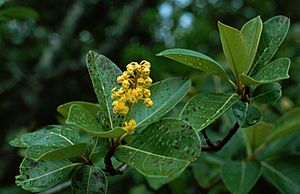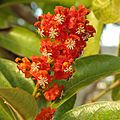Nance facts for kids
Quick facts for kids Nance |
|
|---|---|
 |
|
| Byrsonima crassifolia | |
| Scientific classification | |
| Genus: |
Byrsonima
|
| Species: |
crassifolia
|
| Synonyms | |
|
Malpighia crassifolia L. |
|
| Nutritional value per 100 g (3.5 oz) | |
|---|---|
| Energy | 306 kJ (73 kcal) |
|
16.97 g
|
|
| Sugars | 8.31 g |
| Dietary fiber | 7.5 g |
|
1.16 g
|
|
|
Protein
|
0.66 g
|
| Vitamins | Quantity
%DV†
|
| Vitamin A equiv.
lutein zeaxanthin
|
1%
5 μg
569 μg
|
| Thiamine (B1) |
1%
0.015 mg |
| Riboflavin (B2) |
2%
0.018 mg |
| Niacin (B3) |
2%
0.29 mg |
| Pantothenic acid (B5) |
4%
0.18 mg |
| Vitamin B6 |
2%
0.021 mg |
| Folate (B9) |
2%
8 μg |
| Vitamin C |
111%
92.5 mg |
| Vitamin E |
8%
1.25 mg |
| Vitamin K |
11%
11.9 μg |
| Minerals | Quantity
%DV†
|
| Calcium |
5%
46 mg |
| Iron |
3%
0.38 mg |
| Magnesium |
6%
20 mg |
| Manganese |
12%
0.248 mg |
| Phosphorus |
1%
10 mg |
| Potassium |
8%
244 mg |
| Sodium |
0%
3 mg |
| Zinc |
1%
0.09 mg |
|
Link to USDA Database entry
|
|
| †Percentages estimated using US recommendations for adults. | |
The Byrsonima crassifolia is a tree that grows slowly and comes from the tropical parts of America. People call it by many names like changunga, nance, craboo, and golden spoon. In Jamaica, it's known as hogberry. This tree is mostly grown in countries like Peru, Southern Mexico, Brazil, Puerto Rico, and the Dominican Republic. It belongs to the Malpighiaceae family, which also includes the acerola plant.
This tree loves warm, tropical, and subtropical weather. It grows yellow, orange, or red flowers from spring to fall. Its fruits ripen in August and September. The fruit is yellow with white, juicy flesh. It has a strong, unique taste. Butterflies, bees, and birds are often attracted to its flowers and fruits.
Contents
About the Nance Tree
The Nance tree, or Byrsonima crassifolia, can be a large bush or a tree. It grows up to about 33 feet (10 meters) tall.
What it Looks Like
- Leaves: The leaves grow in pairs opposite each other. They are oval-shaped, about 3 to 17 cm long and 4 to 7 cm wide.
- Flowers: The flowers are yellow, dull orange, or red. They have five petals and grow in clusters that can be 10 to 20 cm long.
- Fruit: The fruit is small and round, like a ball. It's about 0.8 to 1.5 cm across. The fruit has thin skin and white, juicy flesh with a strong, special smell. Inside, there are 1 to 3 white seeds.
- Bark: The tree's bark is dark brown, rough, and has cracks. The inner part of the bark is pinkish. The trunk can be tall or short, straight or twisted.
What's Inside? (Nutritional Value)
The Nance fruit is packed with good stuff! If you eat about 112 grams of Nance fruit, you'll get:
- Lots of water (over 90 grams!)
- About 82 calories
- Some protein and fat
- Plenty of carbohydrates, including sugars like glucose and fructose
- A good amount of dietary fiber, which is great for your digestion
It's also a fantastic source of vitamins and minerals:
- Over 100% of your daily Vitamin C!
- Good amounts of manganese, Vitamin K, and Vitamin E
- Smaller but still helpful amounts of potassium, iron, magnesium, calcium, and copper
Images for kids
-
Nance fruit from Guatemala City
See also
 In Spanish: Nanche para niños
In Spanish: Nanche para niños





